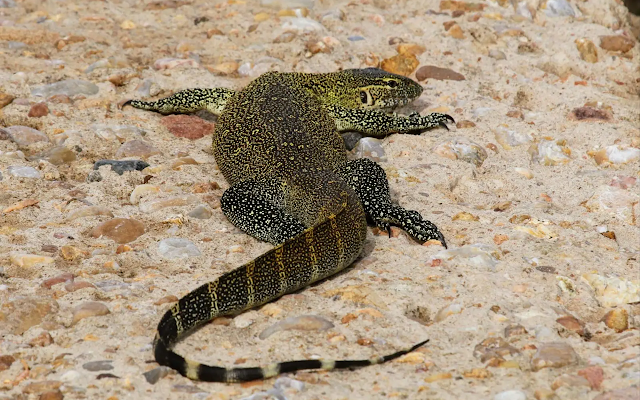20 facts about the Nile Monitor:
The Nile Monitor (Varanus niloticus) is a large species of lizard that belongs to the family Varanidae.
It is one of the largest species of monitor lizard, reaching lengths of up to 2.1 meters (7 feet).
Nile Monitors have a strong and muscular body, long neck, powerful legs, and a long tail.
They have a distinctive pattern of yellow spots and stripes on their dark brown to black skin.
Nile Monitors are native to Africa, ranging from Senegal to Ethiopia, and south to South Africa.
They can be found in a variety of habitats, including forests, savannas, wetlands, and along rivers and streams.
Nile Monitors are opportunistic carnivores, feeding on a wide range of prey including fish, frogs, reptiles, birds, small mammals, and carrion.
They are also known to raid crocodile nests to eat the eggs and hatchlings.
Nile Monitors are known for their aggressive behavior and powerful bite, and are capable of inflicting serious injury to humans.
However, they are also valued for their meat and skin in some African countries, and are even kept as pets in some parts of the world.
Nile Monitors are excellent swimmers and can hold their breath for up to an hour underwater.
They are also skilled climbers, using their sharp claws and powerful legs to ascend trees and other vertical surfaces.
Nile Monitors are solitary creatures, except during mating season.
Females typically lay 20-60 eggs in a burrow or hole in the ground, and the eggs hatch after around 6 months.
Nile Monitors are highly adaptable and have been introduced to several countries outside of their natural range, including Florida, USA.
They are considered an invasive species in some areas due to their ability to outcompete and prey upon native species.
Nile Monitors are listed as a species of "Least Concern" by the International Union for Conservation of Nature (IUCN).
However, they are threatened by habitat loss, over-harvesting for the wildlife trade, and persecution by humans.
Nile Monitors play an important role in their ecosystem by controlling populations of prey species and serving as prey for larger predators.
They have also been studied for their unique adaptations, such as their ability to tolerate high levels of salt in their bloodstream.





0 Comments